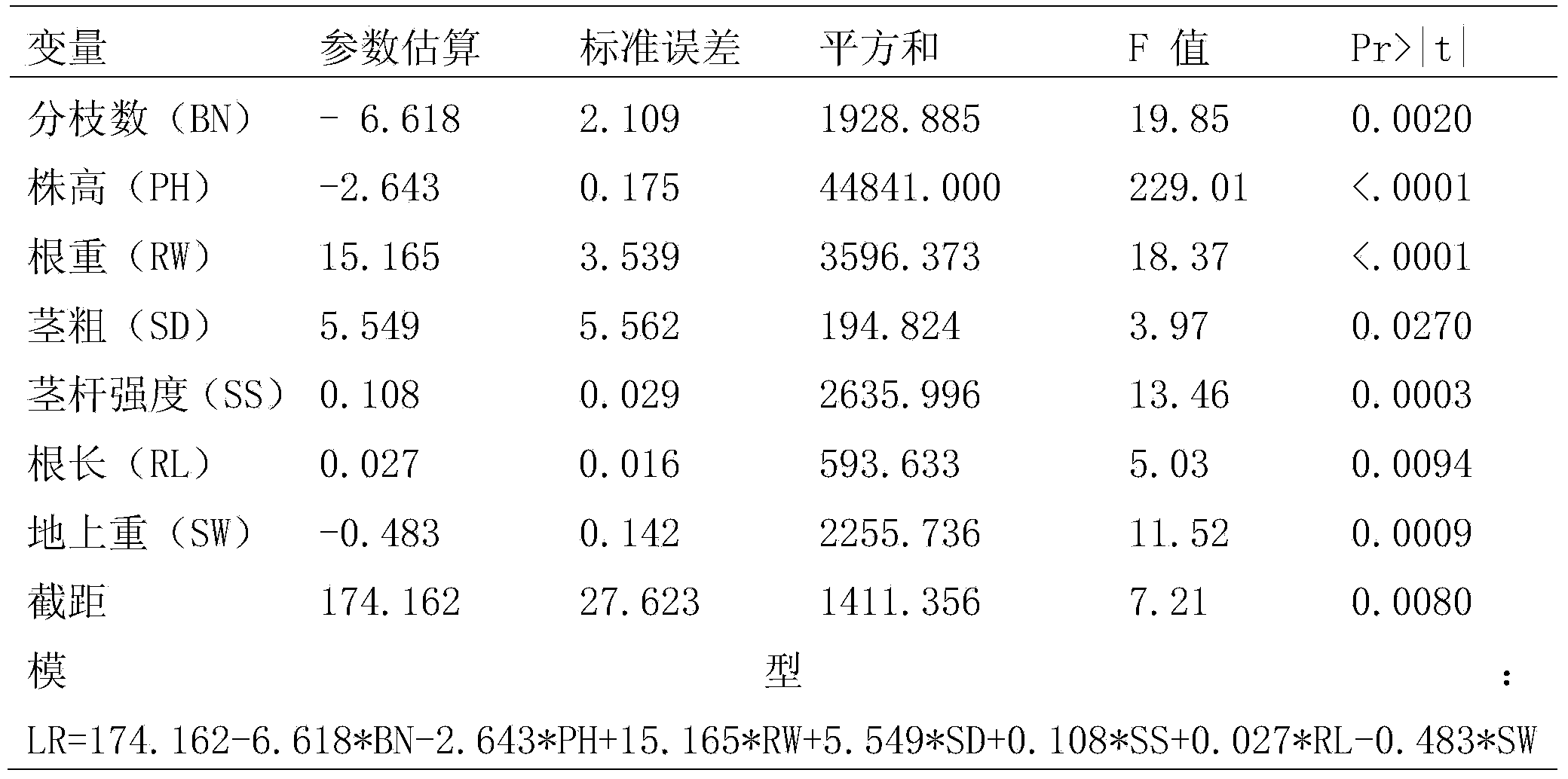Method and model for predicting lodging resistance of soybeans
A lodging resistance and soybean technology, applied in the biological field, can solve problems such as large limitations, scientific evaluation of lodging resistance of difficult varieties, and environmental vulnerability, and achieve the effects of saving production costs, convenient and fast detection methods, and improving selection efficiency.
- Summary
- Abstract
- Description
- Claims
- Application Information
AI Technical Summary
Problems solved by technology
Method used
Image
Examples
Embodiment 1
[0024] Embodiment 1, the method for predicting soybean lodging resistance
[0025] A soybean recombinant inbred line population containing 406 families was derived by crossing the soybean varieties Zhongdou 29 (lodging rate 17.8%) and Zhongdou 32 (lodging rate 62.5%) with significant differences in lodging (Zhou Xinan et al., Three- and four-pod variation of soybean recombinant inbred lines and its relationship with yield, Chinese Journal of Oil Crops, 2005, 27: 22-25).
[0026] In the mid-pod stage, the stalk strength (SS) was measured with a Japanese stalk strength tester (DIK-7401, Daiki 5011 & Moisture). According to the instructions for use, push the measuring device hard and slowly at a distance of 20cm from the ground to make the stem tilt and form an angle of 30 degrees with the ground, and record the measured value displayed on the measuring device at this time. In the middle of each test plot, 10 plants were randomly measured, and the average value was converted int...
Embodiment 2
[0031] Embodiment 2, utilize lodging resistance model to identify the lodging resistance of soybean breeding material
[0032] 1. Soybean materials to be identified
[0033] The F11 family of Zhongdou 29×Zhongdou 32 was obtained as follows: Zhongdou 29 and Zhongdou 32 were crossed, and the offspring of the hybrids were self-crossed continuously, and the F3 was planted in ramet rows, and each subsequent generation was randomly selected from each row. Select a single plant to derive the next generation. Five individual plants were randomly selected from the same family in the F7 generation, the seeds were mixed, and different families were planted separately to obtain a recombinant inbred line population consisting of 406 F11 lines. Among them, the hybridization method from F2 to F11 is self-crossing.
[0034] 2. Using the lodging resistance model to identify the lodging resistance of soybean breeding materials
[0035]From the 406 families in step 1, 30 F11 families (numbere...
Embodiment 3
[0049] Embodiment 3, utilize lodging resistance model to identify the lodging resistance of soybean germplasm resources
[0050] 1. Unidentified soybean germplasm resources
[0051] 30 soybean germplasm resources (see Table 3).
[0052] 2. Using the lodging resistance model to identify the lodging resistance of soybean germplasm resources
[0053] (1) Determination of lodging resistance and related traits by random block experiment
[0054] 30 soybean germplasm resources (numbered 31-60) were planted, and the experiment was designed in randomized blocks with three replicated blocks. 30 plots were set up for each repetition, and all experimental materials were planted in the experimental farm of the Institute of Oil Crops, Chinese Academy of Agricultural Sciences. Three rows are planted in each plot, the row length is 3.5m, the row spacing is 0.4m, and the plant spacing is 0.1m.
[0055] 1) Model predicts lodging resistance
[0056] Then randomly and continuously sample 5 ...
PUM
 Login to View More
Login to View More Abstract
Description
Claims
Application Information
 Login to View More
Login to View More - R&D
- Intellectual Property
- Life Sciences
- Materials
- Tech Scout
- Unparalleled Data Quality
- Higher Quality Content
- 60% Fewer Hallucinations
Browse by: Latest US Patents, China's latest patents, Technical Efficacy Thesaurus, Application Domain, Technology Topic, Popular Technical Reports.
© 2025 PatSnap. All rights reserved.Legal|Privacy policy|Modern Slavery Act Transparency Statement|Sitemap|About US| Contact US: help@patsnap.com

